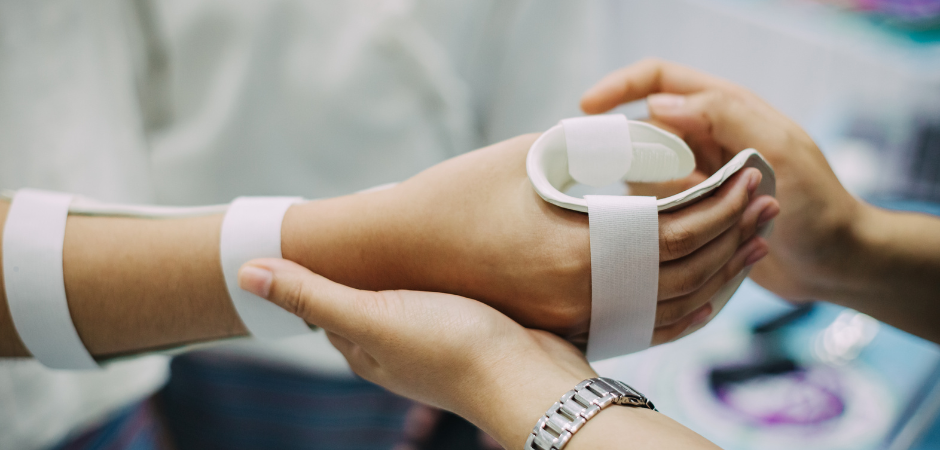October 2024 - This article is adapted from Versus Arthritis (2019)
If we don't use our joints properly we can increase the pain and strain we feel. Over time this can also cause our joints to change shape.
Using joint protection techniques is a great way to relieve pain and reduce the strain we place on our joints. Splinting, using stronger joints and assistive equipment are all examples of joint protection techniques. This article is adapted from our friends at Versus Arthritis, read the article below for tips on joint protection strategies.

Living with joint pain can make everyday tasks like showering, getting dressed, or making the bed feel difficult. However, by changing how you move and carry out these tasks, you can ease the pain and protect your joints, a technique called joint protection or joint care.
Joint protection doesn’t mean avoiding movement altogether, but rather learning how to use your body in a way that minimises strain and potential damage. Research has shown that using joint protection methods can reduce pain and make daily activities easier, especially for those with arthritis.
Many people with arthritis report experiencing less morning stiffness and fewer flare-ups when they consistently use these techniques. A
flare-up is a period when symptoms, such as pain and stiffness, worsen or return. Joint care is especially important for people with
arthritis because it can help reduce pain, manage inflammation, and improve overall mobility.
A joint is where two or more bones meet, allowing movement. The joint is held together by a capsule that limits excessive movement. Inside the capsule, the synovium produces a fluid called synovial fluid, which cushions and protects the joint. The ends of the bones are also coated cartilage which helps prevent the bones from rubbing together.
Muscles are attached to bones via tendons, and when you move, muscles pull on the tendons, allowing movement of the bones.
Arthritis can make daily tasks harder due to joint pain, muscle weakness, and fatigue. Joint protection is important for people with arthritis because it can make activities easier and reduce the risk of worsening symptoms. It can help you manage:
By taking care of your joints, you can help prevent further damage and improve your quality of life.
Arthritis can weaken muscles, making joints less stable. This can lead to damage in bones and cartilage, and over time, joints may change shape.
For people with inflammatory arthritis, such as rheumatoid arthritis, repeated joint swelling can overstretch the ligaments that support joints. The way you use your joints can worsen these issues, which is why joint protection is so important.
Your hands are especially vulnerable because of their small joints and frequent use. Arthritis in the hands can cause pain and limit
movement, making activities like writing or using a phone more difficult.

It’s important to practice joint protection daily, even if your joints are already sore. Protecting your joints can ease pain and prevent further damage.
Joint care is beneficial for any part of your body, but it’s especially important for joints that are affected by arthritis. For instance, if a joint feels painful or is changing shape, it's time to start protecting it. Even small changes in how you use your joints can make a big difference over time.
There are many ways to look after your joints. Exercise can keep them strong, and getting enough rest can help manage pain and fatigue. However, pain can be unpredictable, so it’s important to listen to your body and be kind to yourself on tough days.
Having painful feet can make it difficult to stay active. Comfortable, supportive shoes can help improve your balance and reduce joint strain. It’s important to have your feet measured when buying new shoes, as their shape changes over time. For more information, read our article on Choosing the Right Shoes for Arthritis.
If you have chronic foot pain, a podiatrist can offer advice on how to best care for your feet. They may recommend orthotics, such as insoles or specially made shoes, to relieve pain and correct foot problems. An orthotist, a specialist in devices like splints and insoles, can also provide support for weakened joints and improve mobility.
For more information, read our article on Podiatry
for Arthritis.
Wearing splints can relieve pain if your joints are weak, swollen, or painful. There are two types of splints: working splints for support during daily activities, and resting splints for comfort while resting or sleeping. An occupational therapist or hand therapist can help determine the right splints for your needs.
Some people find that compression gloves are also helpful for reducing pain and swelling, and they can be worn while working or resting.
For more information, read our article on How
Occupational Therapy Can Help.
Pain relief is important, but preventing further damage is key to managing arthritis. Building joint protection habits can make daily tasks, like cooking, cleaning, and dressing, easier.
Some joint protection techniques include:
Pain is a common symptom for many people with arthritis, but it doesn’t always mean your joints are being damaged. While it can be tough, staying active is important because stopping movement might actually harm your joints more.
However, if your pain is severe or seems to be worsening, don’t ignore it. This could be a sign that you’re overdoing it and may need to slow down or adjust the activity to suit your limits.
Pay attention to any discomfort and take breaks about every 30 minutes. If the pain persists, consider taking more frequent breaks next time, which might allow you to continue for longer. For more information, read our article on Pacing for Better Arthritis Management.
Many people stop activities they love, like gardening, when it causes pain. But instead of giving up, try doing the activity in smaller chunks with more rest breaks.
Think about how you're using your painful joints and explore alternative ways to get things done. For example, if your hands hurt when
making tea, you could use both hands to lift the kettle instead of one. If standing is difficult, you might find sitting while doing certain
tasks helps.
Distribute weight across several joints to reduce the pressure on any single joint. For example, using both hands to carry a heavy item can help protect your joints from strain. When possible, use larger, stronger joints to carry out tasks. For example, use your shoulder instead of your hand to close a door, or carry items close to your body to reduce strain.
Overexerting yourself can also worsen joint pain. Make tasks easier by asking for help, lightening your load, and using aids like trolleys, wheelbarrows, or other adaptive equipment. These tools can help you remain independent and reduce the strain on your joints. For more information, read our article on Daily Living Aids.
By following these tips and making joint protection a daily habit, you can help reduce pain, prevent further joint damage, and make daily
activities easier.

Over time, arthritis can damage your joints, pushing them out of their proper alignment. This can make everyday tasks like opening jars, buttoning shirts, or turning doorknobs difficult, painful, or even impossible.
The hands are particularly vulnerable due to their small joints and frequent use, but some positions increase the risk of further damage. For instance, avoid:
You can minimise discomfort and strain by adjusting your hand positions and using both hands when possible.
It’s important to use your joints in stable positions to distribute weight evenly and reduce stress. Try not to push your joints too far. For example, move closer to objects instead of overstretching. Additional tips include:
Changing your habits can be difficult, but making gradual adjustments may reduce joint pain and swelling. Start small by focusing on one task that causes you the most pain, and try making just one change at a time. Over time, these changes can make a big difference.
If you need help:
Many people with arthritis worry about damaging their joints further with exercise, but it can actually help reduce pain, fatigue, and improve mental health. Start slow and gradually increase your activity level with low-impact exercises like walking, cycling, tai chi, or yoga.
Remember, any movement is better than none, and exercise doesn't always require special equipment. Find something you enjoy to stay active
and help your joints. For more information, read our article on Exercising
with Arthritis.
Hand arthritis can make your grip weaker and hands stiffer, which can be frustrating. However, regular hand exercises can help strengthen your grip. Practicing daily, even for a short period, can make a significant impact over time. If your hands are sore, you can use warm water and a sponge to soothe them.
Consult with an occupational therapist, physiotherapist, or hand therapist if you need personalised exercises. To find an occupational
therapist, physiotherapist, or hand therapist, use this search
function tool.
Fatigue is more than just feeling tired—it’s extreme mental and physical exhaustion that doesn’t improve with rest. Many people with arthritis experience fatigue due to chronic pain, medications, sleep disturbances, or low mood.
You can help manage fatigue by:
For more information, read our article on Tips
for Managing Arthritis Pain & Fatigue.
Maintaining a healthy, balanced diet is crucial if you have arthritis, as it ensures you get essential nutrients like calcium, vitamin D, and iron. Additionally, it helps in managing a healthy weight, which is important since being overweight places extra strain on joints such as the knees, hips, ankles, and feet, leading to pain and reduced mobility.
Your meals should consist of a variety of foods from the five main food groups:
A Mediterranean-style diet is particularly beneficial as it includes plenty of fruits, vegetables, oily fish, nuts, seeds, and olive oil.
Some people use dietary supplements to support their joints, but research on their effectiveness is mixed. If you decide to try supplements after speaking with your GP and pharmacist, it’s worth evaluating whether you notice any improvement to determine if you want to continue using them.
For more information, read our article on Is There an Ultimate Diet for Arthritis?
Source:
1. Versus Arthritis 2019. Joint Care. [cited 10 Oct 2024]. Available from: https://www.versusarthritis.org/about-arthritis/managing-symptoms/joint-care/